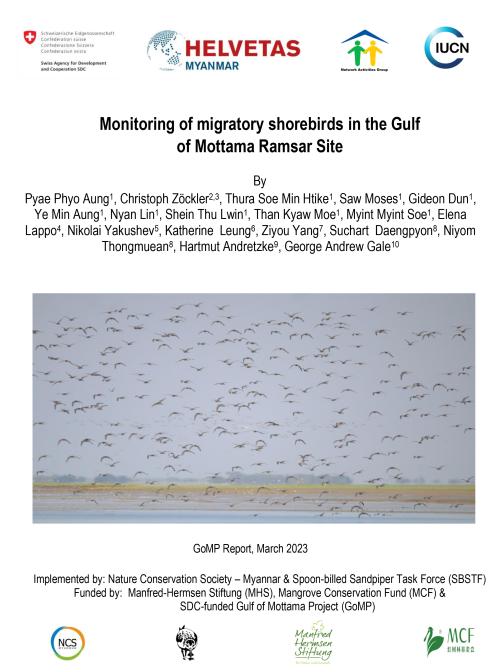With the support of the Mangrove Conservation Fund (MCF), Manfred Hermsem Foundation (MHF) and the Gulf of Mottama Project (GoMP) funded by SDC, the Spoon-billed Sandpiper Task Force and NCS-Myanmar conducted the annual monitoring of the critically endangered Spoon-billed Sandpipers and other migratory shorebirds in the Gulf of Mottama (GoM), Myanmar. Former bird hunters from the Local Conservation Groups (LCGs) joined the survey and guided the survey team to the small wader flocks. They were trained and informed about the survey techniques, biology, and significance of the species in regional, national, and global contexts. The survey recorded a total of approximately 60,000 waders of 53 species in the survey area from 20 to 25 January 2023. The survey recorded 9 critically endangered Spoon-billed Sandpipers (SBS) and estimated to have 16 individuals in total in the GoM, based on the SBS proportion in 198 flock counts of over 32,194 birds which was extrapolated to an estimate of 56,200 birds of small waders in the survey area. These birds were encountered by the team at low tide feeding and widespread across the vast mudflat habitats. Only one flagged Spoon-billed Sandpiper, one flagged Curlew Sandpiper, one flagged Lesser Sand Plover and one flagged Red-necked stint were observed. None could be identified individually. The flagged Spoon-billed Sandpiper was likely marked in S Chukotka (upper left lime flag) while the flagged, Red-necked stint was marked in Kamchatka, Russia (Black over Yellow on the right leg), which might be the same bird recorded over the last two years. One flagged Curlew Sandpiper (Black and Green) which might be tagged in Thailand was also recorded. A flagged Lesser Sand Plover (Black over Green on the right leg) which was also marked in Thailand was also recorded. Of other globally endangered species, 83 individuals of Great Knot and 15 individuals of Nordmann’s Greenshank were observed as well as nine globally near-threatened species such as Black-tailed Godwit (2,040 individuals), Bar-tailed Godwit (91 individuals), Eurasian Curlew (1,072 individuals), Asiatic Dowitcher (183 individuals), Red Knot (21 individuals), Red-necked/Little Stint (4,874 individuals), Curlew Sandpiper (2,455 individuals), Black-headed Ibis (144 individuals) and Painted Stork (4 individuals). The most abundant species were the Lesser Sand plover (24,712). Comparing to the previous years` surveys, the number of threatened species sighted were increased in species as Nordmann’s Greenshank, Common Pochard, Bar-tailed Godwit, Eurasian Curlew, Asiatic Dowitcher and Black-headed Ibis whereas the number of individuals was declining in species Spoon-billed Sandpiper, Great Knot, Black-tailed Godwit, Red Knot and Painted Stork. The decline in these bird populations could be related to such factors as changes in the intertidal mudflats habitat, availability of food sources and, climate change. The number of critically endangered Spoon-billed Sandpipers sighted by the survey team was only 9 individuals, which is a decline of about 50% compared to the 2022 record. The populations’ decline could be due to several reasons especially climate change, habitat changes, hunting and water pollution etc. It is still needed to investigate the resuming hunting pressures and potential habitats in the whole Gulf of Mottama by using remote sensing techniques.
Published By:
Published Date:
